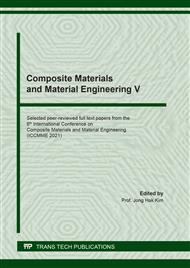p.9
p.15
p.21
p.27
p.32
p.38
p.44
p.53
p.59
Biocomposites Based on Agar and Cellulose Nanofibers Prepared from Carrot Slag
Abstract:
In this study, the effect of cellulose nanofibers (CNF) prepared from carrot slag on the properties of agar biocomposite films is investigated. The composite film was characterized by ultraviolet–visible spectroscopy (UV-Vis), tensile test, fourier transforms infrared (FT-IR) spectroscopy and Transmission electron microscopy (TEM). The transmittance, mechanical properties and chemical structure of the composite film containing different CNF content (0.1, 0.3 and 0.5 phr based on agar) were studied. The UV-Vis showed that the transmittance of the film was decreased with increasing content of CNF. The FT-IR spectrum showed that the generation of hydrogen bonds leads to good interface bonding between Agar and CNF. Moreover, the performance of the bionanocomposite was improved by the addition of CNF. The composite containing 0.3 phr CNF results in a maximum tensile strength of 25.97 MPa. However, the tensile strength of the 0.5 phr CNF containing one is reduced to 24.42 MPa due to the agglomeration of CNF. The TEM shows that the diameter of CNF is 2.5 nm and the length is 18.20 nm. The usage of CNF obtained from carrot slag can not only recycle the waste from food industry, but also can be used as a reinforcing agent for preparing biodegradable composite film. It has potential uses in the development of biodegradable food packaging materials and biomedical applications.
Info:
Periodical:
Pages:
32-37
Citation:
Online since:
June 2021
Authors:
Keywords:
Price:
Сopyright:
© 2021 Trans Tech Publications Ltd. All Rights Reserved
Share:
Citation:


